Home » Hunting Dogs » How English is the English Setter?
How English is the English Setter?
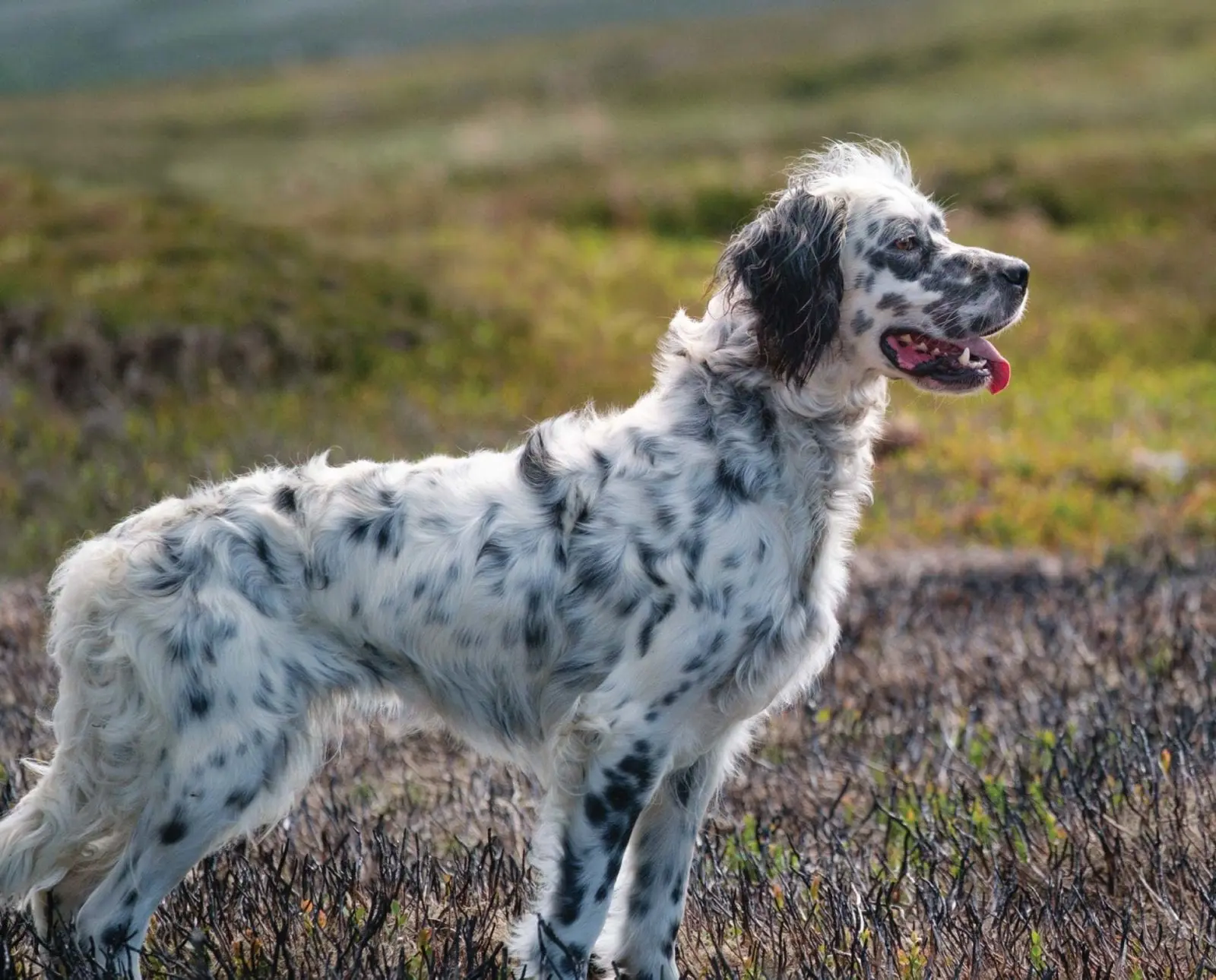
From their home base in Winnipeg, Craig Koshyk and Lisa…
Over time the English setter has become a worldwide phenomenon in the bird dog world—and less English in the process
Wouldn’t it be great to hop in a time machine and visit 13th century England? We could see for ourselves just how medieval hunters bagged partridges the old fashioned way, with old fashioned hunting dogs. But there’d be a problem: none of us would be able to understand a word the hunters were saying, and to us, their dogs would be unrecognizable.
Listen to more articles on Apple | Spotify
Even the 15th and 16th centuries would be a bit too far back. Yes, we’d be able to understand a few more words the hunters said, but it would be a struggle. And even though their dogs would look a bit more like the setters we have today, they wouldn’t run or point like the setters we have now.
If we really wanted to go back to where we could understand just about everything the hunters were saying and where their dogs were similar to the ones we have today, the 18th century is about as far back as we could go.
Back then, almost everything would be familiar to us. The dogs would be recognizable as English setters; they’d range out at speed, point birds naturally and some would even back their bracemates. The hunters would carry shotguns, shoot birds on the wing and we’d be able to converse with them. We’d be at the dawn of the modern world, when the English language and the English setter were poised to conquer the world.
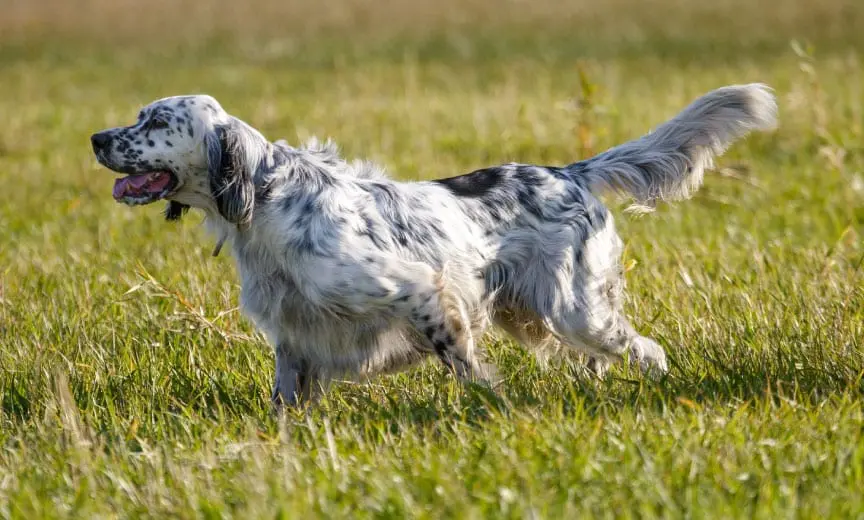
Today of course, we can understand English speaking hunters no matter where we go, and we can probably tell where they’re from just by the accent. And when we see their setters, we’d have a pretty good idea if they were from English, American or European lines just by the way they run and point.
And that is because just like languages, dog breeds usually acquire regional differences over time—they develop ‘accents.’ And like the accents of English speakers in different regions, the differences between strains within breeds of dogs range from barely noticeable to so great you’d think they were completely different breeds.
So what are the main ‘accents’ among field-bred English setters around the world, and how strong are they? In America, they are comparable to different accents of American English—noticeable, but relatively easy to understand. American-bred setters from American field trial lines are fast, wide-ranging dogs, towards the smaller end of the spectrum. At the opposite end are Ryman and Old Hemlock type setters, larger, closer working, stately ‘grouse dogs.’ In between the two extremes are other types, from Llewellins to European imports.
But when you compare the accents of setters in America with those in Europe, the differences are massive—like an Irishman, a Texan and an Australian reading Shakespeare.
The vulnerable native English Setter
Yet the differences in accents pale in comparison to the differences in numbers. Ninety-nine percent of the world’s English setter population is located outside of England. English breeders only register about 400 pups per year with the Kennel Club which recently declared it a vulnerable native breed.
So what’s going on? How did we get to the point where the English setter is teetering on the brink of extinction in England?
The first thing to keep in mind is that the breed’s decline in Britain is not a recent phenomena. A downward trend was detected as early as the 1850s and by 1900 all the pointing breeds native to Britain and Ireland were struggling. Derry Argue, in his excellent book Pointers and Setters, shed light on some of the reasons for the decline.
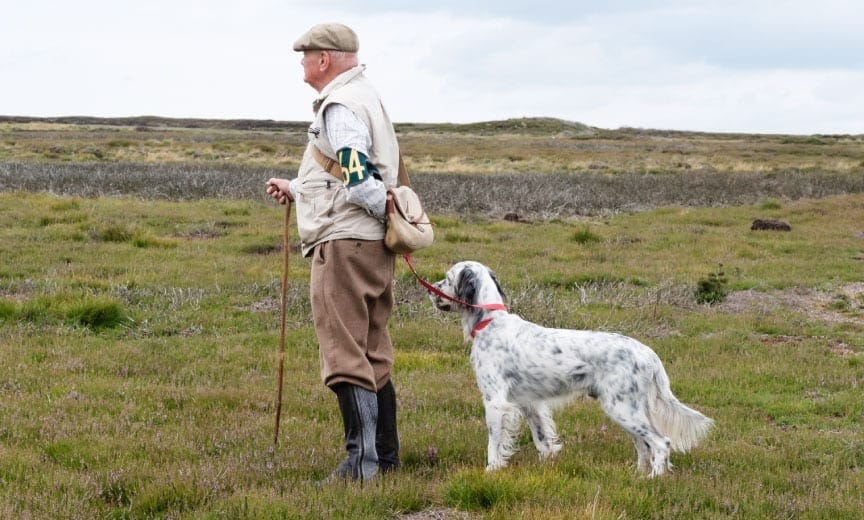
“The demise of the general popularity of shooting over pointers and setters came about through many small factors. Changes in feed formulation permitted the artificial rearing of game birds on a scale hitherto only dreamt of. The Continental fashion for ‘battu,’ i.e., driven shooting, was gaining in popularity and was given the seal of royal approval by Prince Albert, Queen Victoria’s German husband, who was keen on this type of sport. Who would dare to condemn the practice as ungentlemanly or unsporting now? More traditional British sportsmen had condemned this style of shooting for generations; now it was dogging that was decried as ‘old fashioned.’”
In Nature and Sport in Britain, published in 1904, H.A. Bryden predicted shooting over setters would eventually die out in the U.K.:
“The keen delight of shooting over dogs is more and more becoming a thing of the past . . . Its decline began in 1870, or a little before; its complete extinction may be supposed to be looked for before 1950.”
Another important reason why setters fell out of favour—and the reason why they probably will never be popular in England again—is the fact that suitable terrain to run them on became increasingly hard to find.
“Perhaps the low ground could produce pheasants and partridge but the ground cover beloved by the game birds had disappeared. Hand reaping left knee-high stubbles. The new reaping machines shaved stubbles to ground level and the straw was carted off . . . (hunting over setters) fell out of fashion in every area except where there was no other way of coming to terms with game.” —Derry Argue, Pointers and Setters, p.38
The final nail in the coffin may have been the fact that British sportsmen have always had a taste for new and exotic pointing breeds from other countries. Nowadays, as the English setter struggles to survive in England, breeds like the German shorthaired pointer, weimaraner and vizsla remain hugely popular. But once again, the trend began long ago. In 1900, William Arkwright wrote:
“It is odd that a club founded more or less in the interests of the English sporting breeds should so soon have forsaken them to run after foreign dogs that are useless in England; but, as Dr. Caius remarked over three hundred years ago, ‘We Englishmen are marvelous greedy gaping gluttons after novelties, and covetous cormorants of things that be seldom, rare, strange and hard to get.’ He knew his fellow countrymen then—and now!“
Clearly the foreign dogs are not ‘useless in England.’ Obviously some have proven to be very good hunters and most have earned relatively good reputations among British hunters. Nevertheless, Arkwright is correct; British hunters, for a variety of reasons, did turn their backs on their native pointing breeds in favour of ‘rare, strange and hard to get’ breeds from the Continent.
So if English setters are struggling to survive in England, where are they thriving?
English Setters in North America and Europe
In the U.S., it is difficult to determine exactly how many setters are produced each year. However, based on information published by the AKC and the FDSB, it looks like approximately 3000 English setters are registered each year with probably another 500 to 1000 born but not registered. So if we take the highest estimate, say 4000 per year, and estimate a life expectancy of 8 to 10 years, the entire population of English Setters in the U.S. would work out to something like 30 to 40 thousand, about 100 times the number in England.
We should also keep in mind that even though imports from England were common in the early days, they basically slowed to a trickle over 100 years ago when Americans began to produce dogs that were every bit as good, and in many ways, better, than the dogs back in the U.K. So the two populations have, for all intents and purposes, been isolated from one another for over a century, plenty of time for their look and working styles to diverge.
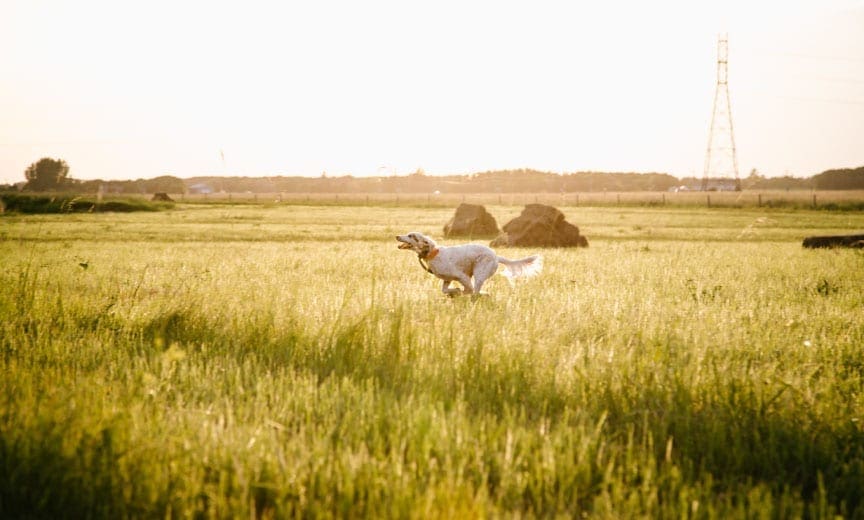
The most obvious difference between American bred English setters and those bred just about everywhere else is tail carriage. An American English setter runs with an animated ‘cracking’ tail and holds it ‘at 12 o’clock’ when on point. English setters in England don’t have as much tail action when running and when on point; they tend to hold their tail level with the back or just slightly raised. More importantly, American English setters have been bred for more speed, range, and especially, more endurance than their English cousins.
So if there are 100 times more English setters in the U.S. than in England, in terms of numbers, are Americans the world’s number one producer?
Listen: Pointers and Setters on the English Moors with David Hudson: Hunting Dog Confidential Episode #20
Italy’s obsession with the English Setter
No. Similar numbers of setters are registered in Spain and slightly more in France. But Italy leads the pack, by a mile. With annual registrations ranging from 10 to 20 thousand pups, Italian breeders sometimes register more English setters than the rest of the world combined.
So why is the English setter so popular in Italy, of all places? To find out, I posted a question on a well-known Italian gun dog forum asking members why they loved the English setter so much. Some of the answers affirmed my belief that the sporting press can have a huge effect on a breed’s popularity. One respondent wrote:
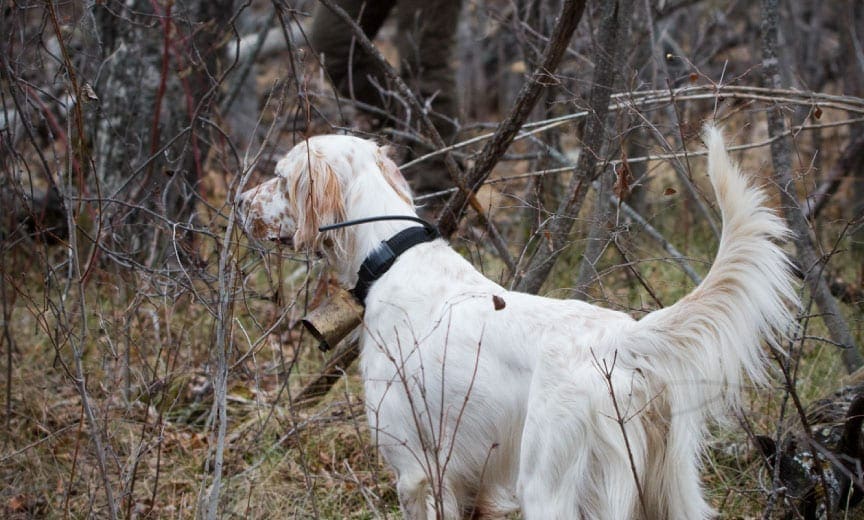
“The English setter is the most popular dog here because many of the big-name writers of the 50s, 60s and 70s were setter enthusiasts. Vincenzo Celano’s books about hunting woodcock with setters for example were very influential. And all you had to do was open any hunting magazine like Diana and you’d see article after article about English setters.”
Others who submitted replies supported my assertion that once a breed achieves a certain level of popularity, it can completely dominate the scene of an entire region or country.
“Ninety-five percent of hunters in my valley hunt over setters. I have them because all my hunting friends have them. My father had setters before me, and so did his father. Around here, the word ‘setter’ is more or less synonymous with hunting dog.“
Another respondent, only half-jokingly, wrote that English setters appeal to Italians’ love of art and culture.
“Italian people have very refined tastes. We love good food, wine, fashion, design and architecture. Don’t forget, Italy is the home of some of the greatest artists, writers and composers in history. So a breed like the English setter, with its striking beauty and incredible talents, fits in perfectly with our passion for the finer things in life.”
Unlike Americans, Italians were not early adopters of the English setter. They didn’t really start breeding them until the early 1900s, and it wasn’t until after World War II that they began producing significant numbers of setters. But over the last 50-60 years, they’ve made tremendous progress. Italian-bred English setters completely dominate the hunting and field trial scene across almost all of Europe and can be found in the homes of hunters from Spain to Sweden, France to Russia.
As for their ‘accent,’ the best word to describe their look and working style is ‘feline.’ They are extremely fast, wide-ranging dogs that gallop close to the ground, head held high, tail moving only slightly. When moving up the scent cone, they advance like a panther stalking its prey. On point, they typically crouch very low to the ground or lay flat on their belly, neck fully extended, head and nose pointing upwards.
Of course both American and European populations of English setters are divided between show-bred and field-bred lines. Fortunately for hunters, show-bred dogs are in the minority just about everywhere and that means finding a well-bred, hard hunting English setter is relatively easy.
So how English is the English setter? In some ways, the answer is ‘not very much.’ In terms of numbers, looks and working style the breed is now more American, more Italian, more international than it is English. However, the English setter is, and always will be, quintessentially English. Refined over time by brilliant, industrious people, the English setter, like the English language, is a practical, elegant, and highly adaptable product of a small island nation that conquered the world.
From their home base in Winnipeg, Craig Koshyk and Lisa Trottier travel all over hunting everything from snipe, woodcock to grouse, geese and pheasants. In the 1990s they began a quest to research, photograph, and hunt over all of the pointing breeds from continental Europe and published Pointing Dogs, Volume One: The Continentals. The follow-up to the first volume, Pointing Dogs, Volume Two, the British and Irish Breeds, is slated for release in 2020.




Very interesting article. It should be noted that there is a pure line of Llewellin Setter, imported from UK in the 1960’s, from Ireland in 1980’s, and from Belgium in 1990’s that all pedigree lines to go back 100% to Sir. Llewellin’s personal “Dashing Bondhu” dogs. In Llewellin’s day, they were recognized in the UK Kennel Club as a unique strain, with only dogs or pure “Dashing Bondhu” linage being allowed to use “Dashing Bondhu” as part of their name. In an effort to preserve the strong willingness to please, natural bird dog instincts, and original hunting style and size of these wonderful Setters and to prevent out crossing with American field trail strains, they have been carefully bred by dedicated breeder’s within the International Progressive Breeder’s Alliance ‘IPDBA’ and registry since 1996. These are the same bloodlines that produced the TV stars of “Hunting with Hank” and “Upland days with Dash”. They have been preserved pure for over 150 years and still have a bonding nature, strong willingness to please, and making awesome family companions as well natural pointers, retrievers, backers, and more that hunt for you, They are the true essence of the ole’ English Sporting Dog.
“Fortunately for hunters, show-bred dogs are in the minority just about everywhere and that means finding a well-bred, hard hunting English setter is relatively easy.”
I completely disagree with this. Many show breeders hunt their dogs and compete in hunt tests and trials. You just have to do your research before buying. I hunt with bench bred Pointers and English Setters. In fact, I will never buy another field-bred pointing breed again. The average hunter doesn’t need a field-trial dog. In fact, I would argue they’d be happier without one.
What is the difference between the IPDBA and the FDSB & AKC?
“A good bird dog is 90% genetic and 10% training” -Ben O Williams. Show dogs are bred solely for confirmation, hunting dogs are bred for their ability to hunt. After countless generations, there is no denial hunting lines are much better in the field. I’ve watched clubs train show dogs to point and all I could do was bite my tongue, it was embarrassing for the dog and handler, yet they didn’t know better. I’m not saying show dogs can’t hunt, in fact I commend show dog owners for trying, but for the preservation of integrity for any hunting breed, hunting ability should be #1 and show quality #2 or #3.
I think what he means is most average hunters don’t require the high drive of a field trial setter. A bench setter may not do for the hardcore gunner who travels between southern quail plantation and South Dakota pheasant fields, but for the 3 or outings a fall hunter, they may be just right.
This is absolute hog-wash. It is the show-bred strains that lack the genetics, nose, stamina, gait, “practical” conformation, relentlessness, savvy of their field bred counterparts. There is NO advantage what-so-ever in buying a show-bred specimen if you intent to actually hunt your dog. Conversely, there is EVERY verification that a well-bred field dog will make a delightful companion in the home as MOST do today. If there is some insinuated fail in YOUR comments re the field-bred dog as a pet/companion, invest in a mirror. There are rarely bad dogs…just bad owners. In fact, a field bred dog will assuredly make BOTH a wonderful companion as well as a highly efficient field performer/hunter. A show-bred dog (where bigger, longer coat is supposed to be better?!?) will require higher food & maintenance costs, cost more at the Vet, require more coat maintenance, cost more when travelling with your dog, move less gracefully, are less agile, (show dogs actually lumber!) AND “might” make an “OK-at-best” hunter. Feeling lucky? Extend that mistake over the average life-span of a dog and that can be one incredibly costly mistake with a tenure of ~ 15 YEARS!!!! Oh…and here’s THE irony of ironies! The show-bred dog often costs more to acquire!?!?!? This comment is not based on personal preference but rather based on 42 years of experience.
So, what really happened between Alfred King the FDSB and the AKC as it concerned the Llewellin Setter? Can it be proven thru DNA that you have a pure Lewellin?
“When moving up the scent cone, they advance like a panther stalking its prey. On point, they typically crouch very low to the ground or lay flat on their belly, neck fully extended, head and nose pointing upwards”
This spot on!
In fact if an English setter’s style does not happens to resemble a crawl of panther or won’t lay on the point he will got a zero point in the Style section as per the FCI rules. This is basically a disqualification. Those dogs, however great hunters they might be don’t get to breed.
Italy, also produced the most decorated English setter, BIG JIM, who dominated the European field championships for years, especially the Grand Quest division.
His videos are still available online.
I’ve hunted in Italy twice. Setters are literally EVERYWHERE, every field, hunt club and gun shop. And I love the panther like point of the Italian/European setter. Looks so stealthy. I’m at the point of cringing every time I hear a breeders describe their American line setters “that point with STYLE and INTENSITY “🤨 aka the upright tail and high nose. The euro version is way better.
Agreed
Quick correction, Craig: You got your math wrong. If 400 pups are registered every year in England and 4000-ish are whelped each year in America, that’s 10 times as many in America, not 100 times. You figured in the 8-10 year lifespan for the American cohort but not for the English one. Figuring it in for both, you would expect a population of 30,000-40,000 at any given time in the US and 3,000-4,000 in the UK — again, about 10 times as many.